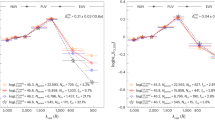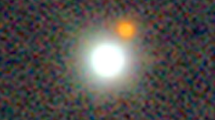Abstract
THE origin of the absorption line systems in quasars is still uncertain1. Most such systems apparently have column densities of atomic hydrogen of the order of 1019cm−2, but, at least two quasars, 1331 + 170 (ref. 2) and PHL957 (ref. 3), have such strong Lyman a absorption lines that atomic hydrogen column densities of the order of 1021 cm−2 are indicated. It should be possible to observe the dust produced 2,200 Å extinction bump as it is redshifted into the visible4, and to determine whether the absorption line systems are produced in spiral galaxies where the dust content is similar to that in the interstellar medium. McKee and Petrosian4 argue that the emission line regions of quasars generally lack dust, and that toward PHL957 the 2,200 Å feature is absent. From recent published data, I argue that dust similar to that found in the interstellar medium is not found toward the quasars 1331 + 170 and PHL 957. This could explain why H2 is not found toward PHL 957, and it also indicates that the absorption line systems in quasars are not produced in spiral galaxies similar to ours.
This is a preview of subscription content, access via your institution
Access options
Subscribe to this journal
Receive 51 print issues and online access
$199.00 per year
only $3.90 per issue
Buy this article
- Purchase on Springer Link
- Instant access to full article PDF
Prices may be subject to local taxes which are calculated during checkout
Similar content being viewed by others
References
Goldreich, P., & Sargent, W., Comments Astrophys 5, 133–136 (1976).
Carswell, R. F., Milliard, R. L., Strittmatter, P. A., Taylor, D. J. & Weymann, R. J. Astrophys. 196, 351–362 (1975).
Beaver, E. A., Burbidge, E. M., Mcllwam, C. E., Epps, H. W. & Strittmatter, P. A., Astrophys J. 178, 95–103 (1972).
McKee, C. F. & Petrosian, V., Astrophys J. 189, 17–21 (1974).
Strittmatter, P. A., et al. Astrophys J. 183, 767–775 (1973).
Jenkins, E. B., Astrophys. J. 169, 25–32 (1971).
Spitzer, L. & Jenkins, E. B. A. Rev Astro. Astrophys. 13, 133–164 (1975).
Jenkins, E. B., Savage, B. D., Astrophys. J., 187, 243–255 (1974).
Bohlin, R. C., Astrophys. J. 200, 402–414 (1975).
Aannestad, P. A. & Purcell, E. M. A. Rev. astr. Astrophys. 11, 309–362 (1973).
Bless, R. C. & Savage, B. D. Astrophys J. 171, 293–308 (1972).
Savage, B. D. Astrophys. J. 199, 92–109 (1975).
Moreton, D. C. Astrophys. J. Lett. 193, L35–L39 (1974).
Coleman, G., et al. Astrophys. J. 207, 1–15 (1976).
Aaronson, M., Black, J. H. & McKee, C. F. Astrophys. J. Lett. 191, L53–L56 (1974).
Bahcall, J. N. & Spitzer, L. Astrophys. J. Lett. 156, L63–L65 (1969).
Author information
Authors and Affiliations
Rights and permissions
About this article
Cite this article
JURA, M. Lack of dust in quasar absorption line systems. Nature 266, 702–703 (1977). https://doi.org/10.1038/266702a0
Received:
Accepted:
Issue Date:
DOI: https://doi.org/10.1038/266702a0
This article is cited by
-
Are QSOs local objects?
Astrophysics and Space Science (1982)
Comments
By submitting a comment you agree to abide by our Terms and Community Guidelines. If you find something abusive or that does not comply with our terms or guidelines please flag it as inappropriate.



